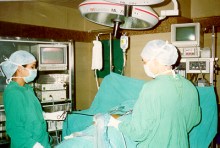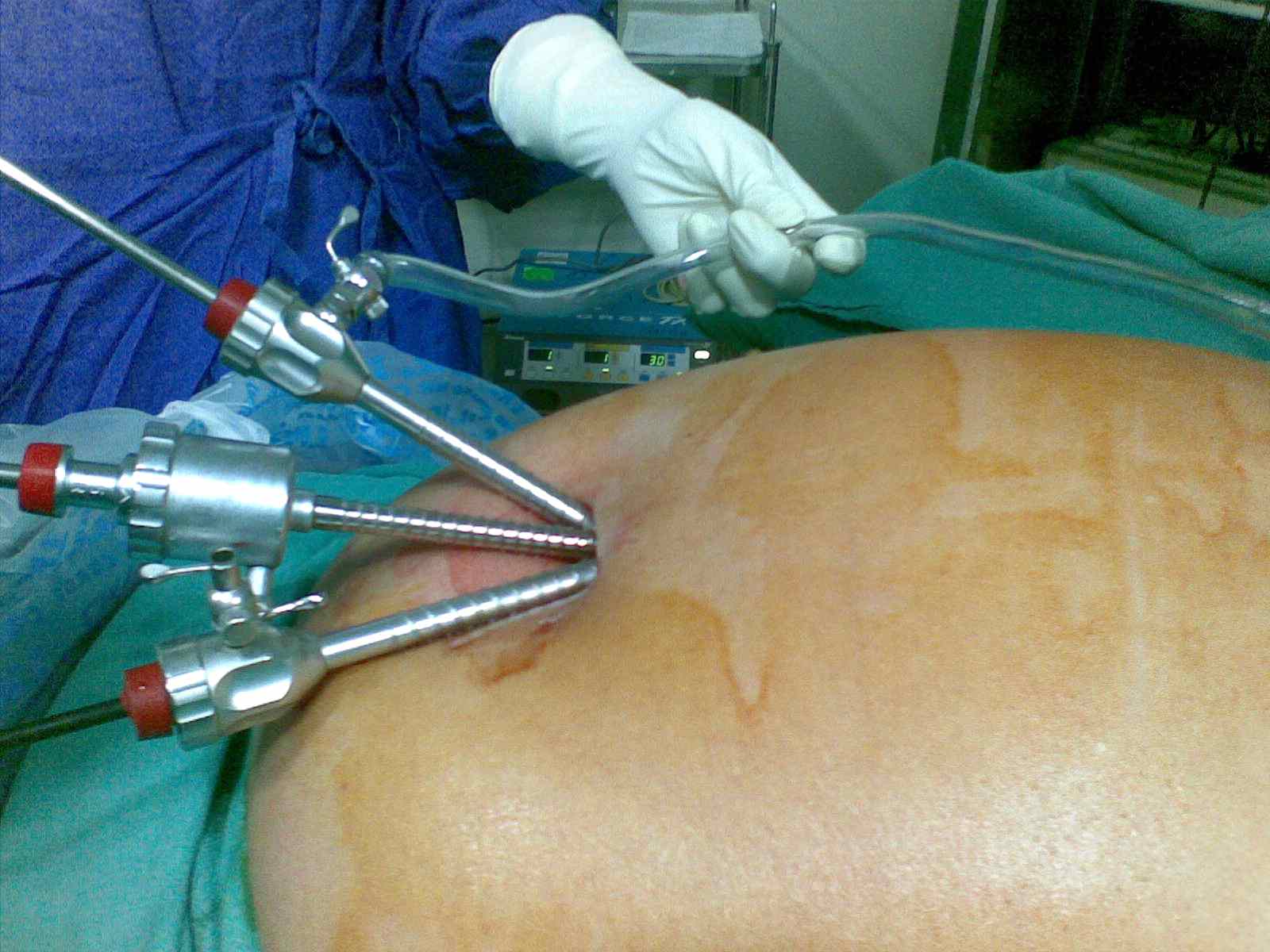
LAPAROSCOPY & MINIMAL ACCESS SURGERY
Dr Arun Prasad, MBBS (AFMC), MS (New Delhi), FRCS (Edin) & FRCS (Glas)
Senior Consultant, Minimal Access Surgery, Apollo Hospital, New Delhi
INDEX OF THIS PAGE
Access to body cavities in order to undertake surgical procedures by other means than making a large cut has been a technique waiting for its time.
Laparoscopic surgical techniques are being applied to a growing number of surgical procedures. Patient's are attracted to the reduced pain and faster recovery associated with the procedures, and surgeons are finding that laparoscopic surgery matches traditional open procedures in terms of effectiveness.
What is laparoscopic surgery ?
Translated from the Greek, "Laparoscopy" means examination of the abdomen with a scope, which is also known as an Endoscope. If the procedure is done in the chest it is known as Thoracoscopy. An Endoscope in the bladder is cystoscopy and in the uterus is hysteroscopy and so on. The other terms used are key-hole surgery and laser surgery.
Explaining laparoscopic surgery is best accomplished by comparing it to traditional surgery. With traditional or 'open' surgery, the surgeon must make a cut that exposes the area of the body to be operated on. Until a few years ago, opening up the body was the only way a surgeon could perform the procedure. Now, laparoscopy eliminates the need for a large cut. Instead, the surgeon uses a laparoscope, a thin telescope-like instrument that provides interior views of the body.
Although laparoscopy has been used for many years by gynaecologists to evaluate pelvic pathology, most surgeons did not recognize its value until laparoscopic gall bladder operation was done. Since that time, the application of laparoscopic instruments and techniques has greatly improved, and new uses are being developed rapidly.
What is Minimal Access Surgery and Minimally Invasive Surgery ?
As use of telescope and fine instruments, spread to other parts of the body, a new terminology was necessary. Strictly speaking laparoscopy is only for the abdomen. Hence the above terms which mean the same came up as an umbrella name under which all endoscopic / telescopic and other surgery could be done in the modern world reducing the cuts and trauma to the body wall.
How is it done?

During laparoscopic surgery, we make a small 1/2 inch cut in the skin at the belly button. Then a cannula (thin tube) is introduced in between the muscle fibres without cutting any of the muscle. Through the cannula, the laparoscope is inserted into the patient's body.
It is equipped with a tiny camera and light source that allow it to send images through a fibre-optic cord to a television monitor. The television monitor shows a high resolution magnified image. Watching the monitor, the surgeon can perform the procedure. While looking inside the patient, further 1/2" or 1/4" diameter cannulas are put in depending upon the procedure e.g. one more for a diagnostic laparoscopy, two more for groin hernia repairs and three more for a laparoscopic gall bladder operation. Instruments are introduced through the cannulas and the operation is performed exactly as one would have done the same procedure at an open operation. All fundamentals of surgery are strictly followed during laparoscopic surgery.
Lately single incision laparoscopic surgery ( SILS ) has come up where all instruments are introduced through the same incision ( many but not all procedures can be done in selected patients using this method ).
The most common question asked is whether laparoscopic surgery another cosmetic operation, the benefit of which is restricted to the bikini wearing public. There are many more advantages of this procedure:
#There is no cutting of the muscles as the holes are made in between the fibres.
#The pain is minimal like one would have after a skin cut.
# Less chance of hospital acquired infections.
# Fewer post-operative chest complications.
# Early return to work.
# No residual weakness.
# Minimal risk of incisional hernias.
# Less disturbing to physiology.
# During hernia operations, already weak muscles are not cut, as would have been the case in open surgery.
# Exploratory ' open & close ' look into the tummy operations are avoided and the same information is gained on diagnostic laparoscopy as a day case patient with one or maximum two holes.
# Avoidance of large cuts and rib removals in the case of thoracoscopic surgery.
# In the case of diagnostic laparoscopy, quick information is gained and the entire procedure can be recorded on video and further opinion can be taken from other surgeons in case of a diagnostic dilemma.
# Despite small holes, there is no compromise in the field of vision. Much more of the 'insides' can be seen than is possible at an open operation. Unlike the 'mini-incision' operations, here the entire tummy can be visualised ensuring no abnormal anatomy or pathology is missed.
How are the operations done?
During a laparoscopic gall bladder operation, the assistant grasps the gall bladder and the surgeon frees its duct and artery. These are then clipped or tied off and the gall bladder removed from the liver bed. After ensuring that there is no bleeding or injury, the gall bladder including the stones is removed with one of the cannulas. The skin is closed with absorbable sutures. Patient should be able to go home in 12-24 hours after surgery.
During a laparoscopic hernia repair, three holes are made at the level of the belly button and the hernia reduced. A non reactive mesh is put over the hernia defect site and fixed in position. The approach to the hernia is not through already weak muscles as is the case with open hernias hence chances of recurrence are less. The greatest advantage of laparoscopic surgery for hernias is in patients of recurrent hernias where the anatomy has already been disturbed andalso in patients of hernias on both sides, as they can be repaired through the same three holes avoiding any further pain or trauma.
position. The approach to the hernia is not through already weak muscles as is the case with open hernias hence chances of recurrence are less. The greatest advantage of laparoscopic surgery for hernias is in patients of recurrent hernias where the anatomy has already been disturbed andalso in patients of hernias on both sides, as they can be repaired through the same three holes avoiding any further pain or trauma.
For patients of pain abdomen where a cause cannot be found after a string of expensive investigations, a diagnostic laparoscopy can provide rapid answers. The patient with doubtful appendicitis is best evaluated laparoscopically and patients with suspected TB abdomen could have a laparoscopic biopsy of the lymph nodes or an intestinal biopsy to make a quick and objective pathological diagnosis.
The other established laparoscopic procedures include bariatric or weight loss surgery, treatment for ovarian cysts, hysterectomy, hiatus hernia, peptic ulcer surgery, intestinal resections, direct vision liver biopsy, division of adhesions, laparoscopically assisted intestinal resections, etc. and some of the thoracoscopic procedures are for achalasia cardia, cysts, lung biopsies etc.
The are many questions that come to one's mind when faced with a new technology like laparoscopic surgery. Some of these are:
Q. Do you only remove the stones from the gall bladder?
A. No, the gall bladder is removed with the stones exactly like it would have been in an open operation.
Q. How can it be removed from such a small hole?
A. The human body has a great capacity to stretch. The holes can stretch quite easily whiteout any harm to the body. In a way, it is similar to child birth.
Q. How is it disconnected from the liver and ducts?
A. The ends are clipped with titanium clips, which is a non reactive element. The safety and superiority of titanium has been proved over 50 years in its use for various purposes in the body in India and abroad.
It is also possible to tie these structures like it is done during open surgery. This procedure is slightly more difficult technically and at present is being done by few surgeons only who are doing mini/micro-laparoscopic surgery, which is going to become the standard method in the 21st century.
Q. What is the recovery period?
A. The patient can start drinking liquids soon after coming out of the anaesthesia which is about 4 hours after the operation. They can start eating soon thereafter. The patient is allowed to get off the bed 4 hours after the surgery and walk to the toilet to pass urine. They are usually allowed to go home the next day, can climb stairs and the majority can get back to routine activity in 5 days and back to work in about 10 days.
Q. Is this operation safe in a fat patient?
A. The operation is ideally suited for the fat patient as the thickness of the tummy wall is immaterial when putting in the telescope and instruments. This is in contrast to an open operation where the fatter patient has a deeper and larger cut causing more bleeding, stitches, and pain.
Q. Is it more risky for patients with other medical problems like diabetes and blood pressure?
A. No. On the contrary, the absence of any major cuts to the body causes minimal disturbance to the physiology. Also the early mobility and return to normal diet makes it easy for the body to recover.
Q. Is their any danger from the telescope inside the body?
A. No, the telescope is used only to see and is not involved with the operation.
Q. Is there an increased risk of infection?
A. No, the small cuts mean that less of the body is exposed to infection.
Q. Why do you approach the hernia from inside?
A. The hernia is protrusion of the body contents through the weakness in the muscle. It is logical that something coming from inside is best dealt from inside. Also this way one does not cut and weaken the already weak muscles at the hernia site. (For more details, click here to visit site on Hernia)
Q. How safe is it to leave a mesh inside the body?
A. The mesh used is the same as the one used for open operations over last 30 years. Its safety and efficacy is beyond doubt as proved by the numerous trials in the USA and Europe.
Q. Is this all very expensive? How can one justify the cost of the equipment and surgery in a country like India?
A. The initial cost of setting up is about Rupees ten lakhs which is nothing when compared to the amount of money the government and private hospitals spend on other things. Once the initial setting up expenditure is covered, the cost of surgery is actually less as has been proved by numerous studies in the USA and the UK.
Q. Will this mean very high bills in private institutions?
A. No, as the hospital stay is reduced by 75%, the extra operation cost will be compensated by the reduction in the room charges. CLICK HERE FOR DETAILS OF COSTING IN INDIA
The increased cost should be compared with the gain associated by a quicker and more productive return to work by the majority of the patients. The hidden lowering of cost is due to less leave, early return to normal activity and work, and also from the greatly reduced disruption of the family routine.
Q. What benefit is this to the government institutions?
A. Owing to early discharge, it opens up beds for other patients who would have otherwise have to wait for their treatment. The government saves resources in terms of food, nursing care etc. on these patients and it can be relocated to other patients.
Q. Who benefits the most from laparoscopic surgery?
A. Everybody. The father who returns to work quickly (tremendous benefit for the self employed ) , the mother can resume work or get back to home soon and take charge of the disrupted household as may the case be. Children are able to return to school soon and do not miss out on studies or sport.
Q. Is there any benefit to the employers?
A. Yes, it means less sick leave and early return to work e.g. after a gall bladder operation, an employee finds it difficult to resume work till about 6 weeks to 3 months. Here, they can be back to work in a week.
Q. What about the poor people?
A. In a country where manual labour is the main source of income to the large majority, avoiding a cut in the muscles can only have long term beneficial results. You can imagine the significance to a rickshaw puller or a construction site worker who can resume his work in two week after a laparoscopic hernia repair compared to three months after conventional open hernia repair.
Q. Is there any specific condition prevalent in India where it has a special role?
A. Yes, at times a surgeon has to do an operation of opening up the abdomen or the chest to find out what is wrong with a patient. This may be due to lack of availability of sophisticated diagnostic tools like CAT scan, MRI scan etc. On other occasions, even these investigations do not provide the answer. In such situations, a diagnostic laparoscopy/ thoracoscopy can provide a quick diagnosis and on occasions treatment.
Q. Any particular disease?
A. TB of the abdomen is a difficult condition to diagnose. The main complaint is usually non specific pain in the tummy and on most occasions, the treatment is based on suspicion rather than any objective criteria. In such situations, laparoscopy can provide the answer.
The other situation is when all X Rays and Scans point towards a cancerous condition in side the body but treatment cannot be started unless a part of it is biopsied and examined under the microscope. Here instead of the tummy being cut open to get the information, the laparoscope can be put in to see and also take a biopsy. This is of immense benefit to patients who require chemotherapy rather than surgery for the final treatment.
Q. What is new in Laparoscopic Surgery ?
A. With the advancement of technology, the engineers and manufacturers have responded with telescopes of smaller diameter like 5 mm and 3 mm as opposed to the 'conventional' laparoscopic 10mm telescopes. Also instruments are being developed of 3 mm diameter. This advancement is known as mini/micro/needloscopic laparoscopic surgery. (For more details, click here to visit site on Microlaparoscopy).
 The other advancement is Single Incision Laparoscopic Surgery. Click here for details on SILS.This is going to be the technique of 21st century. While gall bladder and appendix operations can be done with the same equipment ( hence cost remains the same ), advanced laparoscopic surgery like weight loss bariatric surgery would need special instruments.
The other advancement is Single Incision Laparoscopic Surgery. Click here for details on SILS.This is going to be the technique of 21st century. While gall bladder and appendix operations can be done with the same equipment ( hence cost remains the same ), advanced laparoscopic surgery like weight loss bariatric surgery would need special instruments.
Q. Are there any draw backs of laparoscopic surgery?
A. The danger is from the inexperienced laparoscopic surgeon as there is rarely a more experienced person available for guidance in case of difficulty. Unlike the USA and UK there is no training program here and all depends on individual enterprise. The safer surgeons do not consider it an insult to their ego if they have to convert a laparoscopic procedure to open in case of difficulty. Apart from this, the only other thing is the reduction of sympathy levels from relatives as the hospital stay is so short.
Unlike most other professions, changes within the medical profession are met with some resistance and scepticism. Successful examples and a positive approach are essential for the implementation of such programs. This figure should rise with increase in awareness amongst general practitioners and the public. The future generations while reading the history of surgery will wonder why operations were ever done open.
surgerytimes@gmail.com click here for free email advice
The author Dr Arun Prasad MS, FRCS is a senior laparoscopic surgeon at Apollo Hospital, New Delhi.
Also a teacher and examiner in Surgery for Govt of Indian, post graduate surgical training program (DNB ), Royal College of Surgeons (UK).
He was a surgeon at Charing Cross Hospital and Medical School, London and a teacher in Laparoscopic Surgery at The Royal College of Surgeons, London.
He belongs to the world's first generation of Laparoscopic Surgeons and is a pioneer in this field.